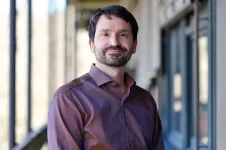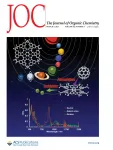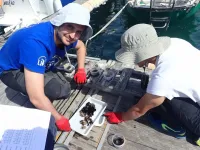New data could inform youth-focused pandemic messaging
Polls of people aged 14 to 24 about masks, distancing and more show the importance of focusing communications on protecting others
2021-04-23
(Press-News.org) Now that teens and young adults across the country account for an increasing share of COVID-19 cases, and many have become eligible for vaccination, several recently published studies based on polls of this age group provide insights into the kinds of messaging that might work best for both preventing transmission and vaccine uptake.
Using data from text-message polls of people between the ages of 14 and 24 taken at several points in 2020, researchers from the University of Michigan find a clear theme: that most young people are taking COVID-19 seriously and trying to follow public health guidance, and that many of them they are motivated by the desire to protect others.
The latest paper, in the Journal of Adolescent Health's May issue, finds that 86% of young people are moderately or very concerned about spreading COVID-19. The data come from the MyVoice poll, which allows open-ended answers to questions texted to a national sample of young people.
At the time the poll was taken, 89% said they wear masks or other face coverings all or most of the time - and the most common reason they gave was to prevent themselves from spreading the coronavirus.
But nearly 20% said that they made exceptions when they were near people they considered close contacts or part of their "pod," and 16% said they based their mask-wearing behavior on social cues, such as whether they felt they could trust that the people they were with had been cautious about potential sources of exposure.
Melissa DeJonckheere, Ph.D., the first author of the paper and an assistant professor in U-M's Department of Family Medicine, says, "By and large, youth thought they were doing the right thing and following face covering guidelines, even when making exceptions. At the time our data were collected, youth were engaged and concerned about their impact on others, and overall wanted to do their part."
Kao-Ping Chua, M.D., Ph.D., senior author and an assistant professor of pediatrics, says that the findings have implications for improving messaging to young people around COVID-19 vaccination, as well as mask use. "Public health campaigns should leverage youths' desire to protect others and not be the cause of spread. Youth may not be very strongly motivated to get a vaccine to protect themselves. A message like "Get a vaccine to protect your grandparents" might be more effective."
Two other recent MyVoice papers found similarly high percentages of youth reported following rules about social distancing for the most part, but making exceptions for close contacts including situations where young people seemed to be misinterpreting public health guidance. Protecting others was cited as the most common motivation for distancing and following other guidance.
INFORMATION:
Citations:
Journal of Adolescent Health
Volume 68, Issue 5, May 2021, Pages 873-881
https://www.sciencedirect.com/science/article/abs/pii/S1054139X21001002
Preventive Medicine Reports June 2021
https://www.sciencedirect.com/science/article/pii/S2211335521000462
Annals of Family Medicine March 2021 https://www.annfammed.org/content/19/2/141
ELSE PRESS RELEASES FROM THIS DATE:
2021-04-23
ABERDEEN PROVING GROUND, Md. -- Army and Arizona State University researchers identified a set of approaches to help scientists assess how well autonomous systems and humans communicate.
These approaches build on transformational scientific research efforts led by the Army's Robotics Collaborative Technology Alliance, which evolved the state of robots from tools to teammates and laid the foundation for much of the service's existing research into how humans and robots can work together effectively.
As ideas for autonomous systems evolve, and the possibilities ...
2021-04-23
Researchers from the Faraday Institution's SOLBAT project have made a significant step in understanding how and why solid-state batteries (SSBs) fail. A paper, published in Nature Materials on 22 April, provides answers to one important piece of the scientific puzzle.
To make step changes in electric vehicle (EV) battery range and safety at a lower cost, new battery chemistries that are "beyond lithium ion" must be developed. SSBs are one such promising technology, but mass market adoption has been held back by several key technical challenges that cause the battery to fail when charged and discharged.
SSBs can short circuit after repeating charging and discharging. One well-recognised cause of battery failure is the growth of dendrites, branching networks of lithium that ...
2021-04-23
An evolutionary biologist from the University of Bonn brought a new octopus species to light from depths of more than 4,000 meters in the North Pacific Ocean. The sensational discovery made waves in the media a few years ago. Researchers in Bonn have now published the species description and named the animal "Emperor dumbo" (Grimpoteuthis imperator). Just as unusual as the organism is the researchers' approach: in order to describe the new species, they did not dissect the rare creature, but instead used non-destructive imaging techniques. The results have now been published in the prestigious journal BMC Biology.
In the summer of 2016, Dr. Alexander ...
2021-04-23
A continental-scale network of conservation sites is likely to remain effective under future climate change scenarios, despite a predicted shift in key species distributions.
New research, led by Durham University and published in the journal Frontiers in Ecology and Evolution, investigates the impacts of potential climate change scenarios on the network of Important Bird and Biodiversity Areas (IBAs) across the Caribbean, and Central and South America.
The research was carried out in collaboration with Senckenberg Biodiversity and Climate Research Centre, BirdLife International and the National Audubon Society.
IBAs are sites identified as being internationally important for the conservation of bird populations, with over 13,000 ...
2021-04-23
There are many different types of cancer, but they all have one thing in common: errors in the signals that control normal cell behaviour can cause uncontrolled cell growth and cell division, leading to a tumour. An enzyme called SHP2 plays a key role in this regard. SHP2 is a signalling molecule that in its activated state stimulates cell proliferation. In a normal healthy body, the rates of cell proliferation and cell death are balanced and tumours do not develop. However, if SHP2 becomes too active, the number of cells being created outweighs the number that die, which can lead to the formation of dangerous tumours. Enhanced SHP2 activity resulting from genetic ...
2021-04-23
Researchers at the University of Cincinnati say a regulatory protein found in skeletal muscle fiber may play an important role in the body's fight or flight response when encountering stressful situations.
The protein, fast skeletal myosin binding protein-C (fMyBP-C), plays a foundational role in the proper regulation of contractile structure and function in the body's fast twitch muscles -- these muscles produce sudden bursts of power to sprint into action, jump or lift heavy objects. Fast skeletal myosin binding protein-C modulates the speed and force of fast skeletal muscle contraction.
"This response ...
2021-04-23
People with type 2 diabetes tend to have poorer muscle function than others. Now a research team at Lund University in Sweden has discovered that in type 2 diabetes, a specific gene is of great importance for the ability of muscle stem cells to create new mature muscle cells. The findings are published in Nature Communications.
"In people with type 2 diabetes, the VPS39 gene is significantly less active in the muscle cells than it is in other people, and the stem cells with less activity of the gene do not form new muscle cells to the same degree. The gene is important when muscle cells absorb sugar from blood and build new muscle. Our study is the first ever to link this gene to type 2 diabetes", says Charlotte Ling, professor of epigenetics at Lund University who led ...
2021-04-23
Recently study on synthetic approaches toward polycyclic aromatic hydrocarbons (PAHs) as graphene with a well-defined structure has attracted much attention. A research group in Ehime University has been studying the synthesis and fundamental properties of pyrrole-fused azacoronene (HPHAC), a nitrogen-containing PAH. HPHACs are composed of electron-rich pyrroles, which are easily oxidized, and their dicationic species in particular exhibit unique features such as global aromaticity based on macrocyclic π-conjugation. However, all the compounds reported so far have bulky ...
2021-04-23
An interdisciplinary group of Spanish scientists, bringing together biologists and chemists from the Universities of Seville, Huelva, the Autonomous University of Madrid and the Institute of Marine Sciences of Andalusia of the CSIC in Cadiz, have just published the results of their pioneering research studying the management of marinas. The group of scientists, led by the US professor José Manuel Guerra García, studied in detail the sediments in Andalusia's marinas and has proposed a new index, the MEPI (Marinas Environmental Pollution Index) to quantify the level of contamination in these ports.
There has been a proliferation of marinas in recent ...
2021-04-23
The giant star featured in this latest Hubble Space Telescope anniversary image is waging a tug-of-war between gravity and radiation to avoid self-destruction. The star, called AG Carinae, is surrounded by an expanding shell of gas and dust -- a nebula -- that is shaped by the powerful winds of the star. The nebula is about five light-years wide, which equals the distance from here to our nearest star, Alpha Centauri.
The huge structure was created from one or more giant eruptions several thousand years ago. The star's outer layers were blown into space, the expelled material ...
LAST 30 PRESS RELEASES:
[Press-News.org] New data could inform youth-focused pandemic messaging
Polls of people aged 14 to 24 about masks, distancing and more show the importance of focusing communications on protecting others







